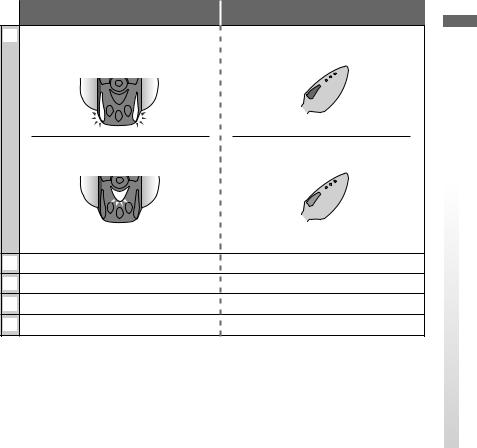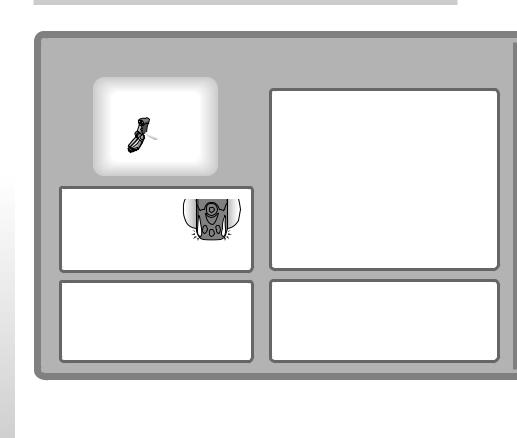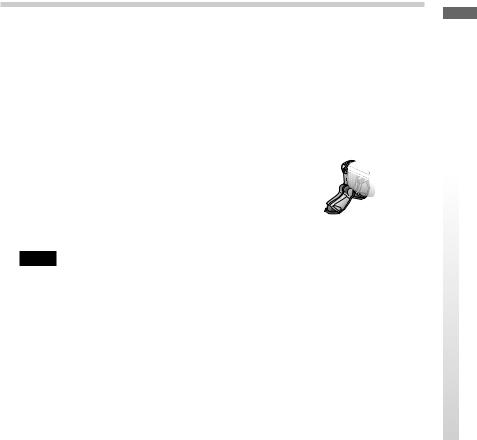Sony ERS-210 AIBO Life 2 ERF-220AW01E, ERS-220 AIBO, ERF-220AW01E User Guide

4-659-724-11(1)
English
Français
Deutsch

En
2
Notice to Users
©2001 Sony Corporation All rights reserved. This manual and the software described herein, in whole or in part, may not be reproduced, translated or reduced to any machine-readable form without prior written approval.
EXCEPT AS SPECIFICALLY SET FORTH IN THE END-USER LICENSE AGREEMENT, SONY CORPORATION PROVIDES THIS MANUAL, THE SOFTWARE AND THE OTHER INFORMATION CONTAINED HEREIN “AS IS” WITH NO WARRANTY AND HEREBY EXPRESSLY DISCLAIMS ANY IMPLIED WARRANTIES OF MERCHANTABILITY, NONINFRINGEMENT OR FITNESS FOR ANY PARTICULAR PURPOSE WITH REGARD TO THIS MANUAL, THE SOFTWARE, OR SUCH OTHER INFORMATION. IN NO EVENT SHALL SONY CORPORATION BE LIABLE FOR ANY INCIDENTAL, CONSEQUENTIAL, OR SPECIAL DAMAGES, WHETHER
BASED ON TORT, CONTRACT, OR OTHERWISE ARISING OUT OF OR IN CONNECTION WITH THIS MANUAL, THE SOFTWARE, OR OTHER INFORMATION CONTAINED HEREIN OR THE USE THEREOF.
THIS DOES NOT AFFECT YOUR STATUTORY RIGHTS.
Sony Corporation reserves the right to make any modification to this manual or the information contained herein at any time without notice.
The software described herein may also be governed by the terms of a separate user license agreement.
This product contains software owned by Sony Corporation and licensed from third parties. Use of such software is subject to the terms and conditions of license agreements enclosed with this product. Software specifications are subject to change without notice and may not necessarily be identical to current retail versions.

Before using this software, please read the accompanying End-User License Agreement which governs use of this software.
•This software or document is protected by copyright, and distributed under licenses restricting its use, copying, and distribution. No part of this software or document may be reproduced in any form by any means and rental of this software may not be allowed without prior authorization of Sony Corporation.
•Sony Corporation assumes no responsibility for any inconvenience caused by
misuse or any use not stated in this document.
•The supplied software cannot be used with any device other than those devices herein.
•The specifications of the supplied software are subject to change without notice.
En
31

Customer Support
How to contact the AIBO Customer Link.
In the United States and Canada
1-800-427-2988
Email address: aibosupport@info.sel.sony.com
In Europe
English line: +44 (0)-20-7365-2937
German line: +49 (0)-69-9508-6309
French line: +33 (0)-1-5569-5117
In Australia
Call +1300-36-2426 (toll free within Australia) E-mail address: cicci@ap.sony.com
In Hong Kong
Sony style
Tel: +852-2345-2966
E-mail address: aibo_helpdesk@shk.sony.com.hk
In Singapore
+65-473-8500
Email address: AIBO.Link@ap.sony.com
4

“OPEN-R” is the standard interface for the entertainment robot system that Sony is actively promoting. This interface expands the capability of the entertainment robot through a flexible combination of hardware and interchangeable software to suit various applications. “AIBO Life 2” ERF-220AW01E confirms to the OPEN-R version 1.1.2.
“AIBO,” the AIBO logo  , “OPEN-R” and the OPEN-R logo
, “OPEN-R” and the OPEN-R logo  are registered trademarks of Sony Corporation.
are registered trademarks of Sony Corporation.
“Memory Stick,” “ ” and “
” and “




 ” are trademarks of Sony Corporation.
” are trademarks of Sony Corporation.
In this manual, the “™” and “®” marks have been omitted.
Other information about AIBO is available on the Internet at the following site: http://www/aibo.com/
Reproduction in whole or in part without written permission is prohibited. All rights reserved.
5

Table of Contents |
|
Getting Started |
|
Checking the supplied accessories ............................................................. |
10 |
About “AIBO Life 2” ................................................................................. |
11 |
About AIBO-ware ........................................................................... |
11 |
AIBO’s autonomous activities ........................................................ |
12 |
AIBO is a robot. Why does it have to be educated? ....................... |
13 |
AIBO ERS-210 and ERS-220 .................................................................... |
14 |
For a user of ERS-210 (notes on descriptions used in |
|
this manual) .................................................................................... |
14 |
Modes and conditions of AIBO ...................................................... |
18 |
Emotions of AIBO .......................................................................... |
28 |
Instincts of AIBO ............................................................................ |
29 |
Preparing AIBO .......................................................................................... |
31 |
Living with AIBO |
|
Charging AIBO’s battery pack ................................................................... |
36 |
When you want to charge AIBO ..................................................... |
36 |
When AIBO wants to be charged ................................................... |
38 |
Sleeping and waking up .............................................................................. |
39 |
Having AIBO sleep ......................................................................... |
39 |
Waking up AIBO ............................................................................ |
41 |
6

Communicating with AIBO |
|
From you to AIBO ...................................................................................... |
44 |
Communicating by touch ................................................................ |
44 |
Communicating visually ................................................................. |
48 |
Communicating by voice ................................................................ |
49 |
Helping AIBO to get up .................................................................. |
50 |
From AIBO to you ...................................................................................... |
51 |
Lights .............................................................................................. |
51 |
Body language ............................................................................................ |
56 |
Sounds ............................................................................................ |
57 |
From AIBO to AIBO .................................................................................. |
58 |
Raising AIBO |
|
Growing up ................................................................................................. |
62 |
Baby stage ....................................................................................... |
63 |
Child stage ...................................................................................... |
65 |
Adolescence .................................................................................... |
66 |
Adult stage ...................................................................................... |
67 |
Finding out AIBO’s maturing stages and character ........................ |
68 |
Learning ...................................................................................................... |
69 |
Teaching what is good and what is bad (Training) ......................... |
69 |
Learning the name .......................................................................... |
70 |
Learning actions ............................................................................. |
72 |
Training ........................................................................................... |
76 |
7

Playing with AIBO |
|
Having AIBO take a photo ......................................................................... |
82 |
Viewing pictures taken by AIBO .................................................... |
84 |
Playing with sounds .................................................................................... |
86 |
Mimicking ...................................................................................... |
86 |
Have AIBO hum a melody ............................................................. |
86 |
Have AIBO emit a melody ............................................................. |
87 |
Turn on AIBO step .......................................................................... |
87 |
Have AIBO sing a song .................................................................. |
87 |
Additional Information |
|
Notes on use ............................................................................................... |
90 |
Troubleshooting .......................................................................................... |
92 |
Reference Materials |
|
Words understood by AIBO ....................................................................... |
96 |
Maturing stages ........................................................................................ |
100 |
Maturing stage of ERS-220 .......................................................... |
100 |
Maturing stage of ERS-210 .......................................................... |
102 |
What can AIBO do at each maturing stage? ............................................. |
104 |
For more information about “AIBO” ERS-210/220 (name of parts, settings, “Memory Stick” use, safety precautions, etc.), refer to the “AIBO” ERS-210/
220 Operating Instructions.
8

Getting Started
Welcome to “AIBO Life 2,” a software application that helps you to raise your AIBO into an entertainment robot that is just right for you.
This chapter provides basic information about AIBO Life 2 to help you to get along well with AIBO.
*In this manual, “AIBO Life 2” ERF-220AW01E is referred to as “AIBO Life 2” hereinafter.

 Checking the supplied accessories
Checking the supplied accessories
Check to see if you have the following accessories before you play with AIBO.
x AIBO-ware “Memory Stick”
x User’s Guide (this manual)
xQuick Guide
xEnd-User License Agreement
10

 About “AIBO Life 2”
About “AIBO Life 2”
About AIBO-ware
AIBO-ware is software that can be executed with AIBO. AIBO by itself is just a “physical body,” and is capable of only the most basic movements.
For more complicated operations, you must use an AIBO-ware “Memory Stick.” AIBO-ware gives AIBO its capabilities and character, so you might think of it as AIBO’s “mind.” By combining AIBO with different AIBO-ware and peripheral devices, you can enjoy AIBO in a variety of ways.
“AIBO Life 2” is AIBO-ware that allows AIBO to move around autonomously and helps you to raise AIBO into the kind of companion that is best for you.
Started Getting
11

AIBO’s autonomous activities
AIBO comes with all the necessary hardware, such as a brain, sensors, motors, and power supply, to move about on its own. AIBO Life 2 has a set of emotions, instincts, learning ability and the capacity to mature. Through AIBO Life 2, AIBO can act according to its own judgments, all the while expressing emotions, collecting information from you and its environment, learning and maturing.
With AIBO Life 2, AIBO will let you know by gesture and sound when it wants you to play with it, and may even call your name. On the other hand, when something catches AIBO’s attention, it may ignore you even when you call its name. Your understanding of AIBO’s autonomous character helps you to enjoy playing with and living with AIBO.
12

AIBO is a robot. Why does it have to be educated?
The reason is that AIBO was born to live together with people. AIBO is capable of autonomous action based on external information from its various sensors and from internal motivations (i.e., its emotions and instincts). Nevertheless, AIBO will not be too self-centered and will always entertain you.
AIBO Life 2 gives AIBO the capacity to learn and mature so that it can react to your actions and its surroundings. For example, if you talk and play with AIBO a lot, AIBO will grow to be sociable. If you prefer to simply watch AIBO, AIBO will become independent and wander around as it waits for you to play with it.
In short, AIBO Life 2 makes it possible for AIBO to adjust to you as it lives with you and matures.
We hope AIBO will become a good friend.
Started Getting
13

 AIBO ERS-210 and ERS-220
AIBO ERS-210 and ERS-220
AIBO Life 2 is compatible with both ERS-210 and ERS-220.
For a user of ERS-210 (notes on descriptions used in this manual)
Although sensors or lights of ERS-220 function in the same manner as those of ERS-210, the names, shapes and locations of some ones are different. In addition, ERS-220 has the unique sensors and lights. In this manual, the parts names, shapes and/or locations refer to those of ERS-220. If you have ERS-210, see the table below to identify the differences.
Parts indicated with the same number mainly function in the same way, but the names, shapes, or locations may be different.
14

ERS-220 |
ERS-210 |
1 Head sensor |
Head sensor |
Press in the |
Give a firm and |
forward direction. |
quick tap. |
Press in the back |
Press for 3 |
direction for 3 |
seconds. |
seconds. |
|
|
Press in the back |
Move your fingers |
|
direction. |
up and down two |
|
|
times while |
|
|
pressing. |
2 |
Face front light A |
The ears of AIBO move. |
3 |
Face front light B |
The mouth of AIBO moves. |
4 |
Color camera, distance sensor |
Color camera, distance sensor |
5 |
Retractable head light |
– |
Started Getting
15

|
ERS-220 |
ERS-210 |
|
6 |
Face side lights |
|
Eye lights |
|
Red |
(Rear) |
|
|
Blue |
(Center) |
|
|
Blue |
(Front) |
|
7 |
Face sensor |
|
Chin sensor |
8 |
Chest light |
|
Chest light |
9 |
Stereo microphone |
|
Stereo microphone |
0 |
Mode indicator |
|
Mode indicator |
16

|
ERS-220 |
|
ERS-210 |
|
qa |
Tail lights |
|
Tail lights |
Getting |
|
Tail lights (left/right) |
|
Tail lights |
|
|
|
|
|
|
|
|
|
Blue |
Started |
|
Blue |
Blue |
|
|
|
|
|
||
|
Tail light (center) |
|
Tail lights |
|
|
|
|
Orange |
|
|
Red |
|
|
|
qs |
Tail sensors (Left/right/center) |
– |
|
|
qd |
Back sensor |
|
Back sensor |
|
qf |
Back multi-indicators |
|
– |
|
qg |
Paw sensors |
|
Paw sensors |
|
|
|
|
|
17 |

Modes and conditions of AIBO
Autonomous mode
AIBO moves around on its own: basic mode of AIBO Life 2.
The mode indicator turns off.
Push the head |
Push the back |
sensor in the |
sensor for 3 |
back direction |
seconds. |
for 3 seconds. |
|
Lift AIBO up*.
Place AIBO on the floor or push the head sensor in the back direction for 3 seconds.
*When you lift up AIBO slowly, it may not enter Pickup condition. In such a case, lift it up more quickly.
Press the face sensor and back sensor at the same time for 3 seconds, or say “Good night” to AIBO.
Gently shake the body of AIBO.
Rest mode
AIBO stops moving around.
Something is caught in AIBO’s joints.
The mode 

 indicator lights.
indicator lights. 
Push the head sensor in the back direction for 3 seconds.
18

Pick-up condition
When you lift |
|
up AIBO, it |
The |
becomes still |
mode |
and quiet in |
indicator |
this mode. |
lights. |
Sleep mode
AIBO sleeps in this mode.
The  mode indicator
mode indicator  goes off.
goes off.
The chest light slowly flashes green.
Place AIBO on the Energy Station.
Move AIBO from the Energy Station.
Place AIBO on the Energy Station.
Station mode
AIBO plays even on the
Energy Station.
Applicable when you use the Energy Station.*
The mode indicator goes off.
*The Energy Station is optional.
Jam condition
The joints of AIBO become loose when something gets caught in them.
The
 mode indicator
mode indicator  flashes.
flashes.
Pause mode (Inactive condition)
Press the pause button
located on the chest of AIBO. AIBO is turned
off.
The chest light turns off.
Started Getting
19

Playing with AIBO in Autonomous mode/Station mode
What can AIBO do in Autonomous mode?
Learning the name
You can teach AIBO its name or your name (see page 70).
The tail lights flash blue.
Communication between AIBOs
AIBO responds to another AIBO when talked to, and then tries to communicate with the other AIBO (see page 58).
The face side lights, tail lights and back multi-indicator slowly flash.
Learning actions
You can teach AIBO a desired action (see page 72).
The tail light slowly flashes red.
Training
You can train AIBO so that it acts as you instruct. After training, you can name the instructed action and register it as well (see page 76).
The tail light lights up red.
20

Taking a photo
After you give AIBO the appropriate voice command, AIBO snaps a picture for you (see page 82).
The tail light flashes blue.
What can AIBO do in Station mode?
Started Getting
Playing with sounds
AIBO can sing a song or emit various sounds (see page 86).
You can enjoy “Playing with sounds” (see page 86) in |
|
Rest mode or Pick-up condition also. |
21 |

Autonomous mode
This is AIBO’s basic mode when “AIBO Life 2” is loaded. When you start up AIBO Life 2, AIBO enters Autonomous mode first.
AIBO obtains information on its surroundings through its camera/microphone/ sensors, and carries out various autonomous actions based on its instincts or emotion as follows.
•When you talk to AIBO, it stops moving and listens to you.
•When you leave AIBO without talking to it, it looks around or moves its body quietly.
•When you leave AIBO without talking to it for a long time, it enters Sleep mode.
•AIBO will explore the room.
•AIBO reacts keenly to a pink ball or moving objects: for example, looks at it from a distance through its color camera or tries to touch it.
•AIBO responds to another AIBO when spoken to, and communicates with it.
See page 20 for the games you can play with AIBO in Autonomous mode.
Notes
•Do not put AIBO on an unstable surface where it might fall or be subject to vibrations.
•Do not place anything near AIBO that may hinder it in its movements.
22

Rest mode
When you do not want AIBO to move, put AIBO into |
|
|
this mode. |
The mode |
|
Push the back sensor of AIBO for 3 seconds. AIBO |
indicator |
|
lies down or sits down, and then carries out |
lights up. |
|
|
||
autonomous actions. In Rest mode, AIBO cannot |
|
|
carry out the following actions: |
|
|
• |
Taking a photo |
|
• |
Learning a name |
|
• Communicating with another AIBO |
|
|
• |
Training |
|
• |
Learning an action |
|
If you want to use any of the functions above, push the head sensor in the back direction for 3 seconds to place AIBO into Autonomous mode.
Notes
•Do not put AIBO on an unstable surface where it might fall or be subject to vibrations.
•Do not place anything near AIBO that may hinder it in its movements.
Started Getting
23

Sleep mode
In Sleep mode, AIBO sleeps, and the chest light slowly flashes green. See page 39 for details of Sleep mode.
The chest light slowly flashes green.
 The mode indicator goes off.
The mode indicator goes off.
Jam condition
If something gets jammed in any of the joints of AIBO, AIBO changes to this condition and all of its joints become loose. This mode is provided to protect your fingers from being caught between the joints of AIBO.
To return AIBO to Autonomous mode, place it on the floor and push the head sensor in the back direction for 3 seconds.
The mode indicator flashes.
24

Pick-up condition
When you lift up AIBO to hold, AIBO draws its legs |
|
in to make it easier for you to hold AIBO (“pick-up |
The mode |
condition”) and moves its head only. This condition |
indicator |
is to prevent you from getting surprised by the |
lights up. |
|
|
movement of AIBO when picking it up, and then |
|
dropping it. |
|
To return AIBO to Autonomous mode, place it on the |
|
floor or push the head sensor in the back direction for |
|
3 seconds. |
|
Note
When you press two or more of the paw sensors of AIBO, AIBO thinks it is placed on the floor, and then returns to Autonomous mode. The mode indicator goes off. AIBO may start walking after returning to Autonomous mode, so do not touch any of its paw sensors when you hold it.
Started Getting
25

Station mode
When you place a moving AIBO on the optional Energy Station (referred to as the “station” hereinafter), it enters Station mode.
In this mode, AIBO enters Sleep mode or wakes up while being charged up, but it will not move from the station on its own.
See page 21 for the games that can be played with AIBO when it is in Station mode.
 The mode
The mode
indicator goes off.
26

Pause mode
When you press the pause button located on the chest of AIBO, the chest light turns off and power is shut down. Be sure to put AIBO into this mode before replacing the battery or the “Memory Stick.” To start up AIBO, press the pause button on the chest again. The chest light turns on green, and AIBO starts moving around.
Where is the name of the pause button derived from?
Unlike other conventional home electrical products, AIBO has no Power switch since AIBO is designed as an “autonomous robot that moves and learns on its own will while communicating with its surroundings.” AIBO carries out autonomous actions when it wants to play, while it asks you to charge it when its battery power grows weak. When it feels sleepy, it enters Sleep mode on its own to rest. Although you can put AIBO into Sleep mode to sleep, it wakes up when it wants to. Therefore, no Power switch is necessary for AIBO.
However, when you need to stop AIBO in an emergency, press the “pause button” to temporarily stop AIBO’s movement. We, therefore, call the button located on the chest of AIBO the “pause button” instead of the “power button.”
Started Getting
27

Emotions of AIBO
AIBO has six emotions: joy, sadness, anger, surprise, fear and discontent. These emotions will change in response to a variety of factors, affecting the behavior of AIBO. Listed below are common scenarios in which AIBO may be seen expressing emotions.
Joy |
Discontent |
Sadness |
Fear |
Anger |
Surprise |
Joy : When AIBO receives praise or plays with a ball.
Sadness : When AIBO cannot find anyone to play with or does not have its ball or something else that it likes.
Anger : When AIBO is left on the station although it is ready to assume activity, or is scolded.
Surprise : When the ball suddenly appears before AIBO, or when it hears a loud noise.
Fear : When AIBO finds itself in front of a steep drop, or is unable to get up from a fall.
Discontent : When the anger of AIBO escalates.
AIBO expresses these emotions through its lights, sounds and body language (See page 51).
28

Instincts of AIBO
AIBO has five key instincts that provide motivation for its actions: love instinct, search instinct, movement instinct, recharge instinct, and sleep instinct.
Love instinct :
AIBO is naturally inclined to interact with people who will give it care. If left alone for a long time, AIBO will call its owner’s name or feel an urge to play.
Search instinct :
AIBO is a fun-loving, curious robotic creature that enjoys discovering new things, satisfying its curiosity. If AIBO does not sense any movement in its surroundings for a long period of time, it will become restless and will look for something new.
Movement instinct :
AIBO enjoys moving around, playing and having new experiences. If idle for a long time, AIBO will start to move around or move its body on its own.
Recharge instinct :
For survival, AIBO is well aware that it must “eat.” Lithium ion battery is the “Food” for AIBO and battery power is craved like clockwork throughout the day between activities. When AIBO is low on battery power, it will request to be charged and will change to the “charging posture” on its own.
Sleep instinct :
AIBO has a natural rhythm that alternates between sleep and activity, so it has an instinct that makes it desire sleep.
Started Getting
29

In response to its instincts, AIBO behaves in a manner that will satisfy its particular desires. If a desire is fulfilled, it will be pleased. If a desire is left unsatisfied, emotions such as fear or anger will grow.
30
